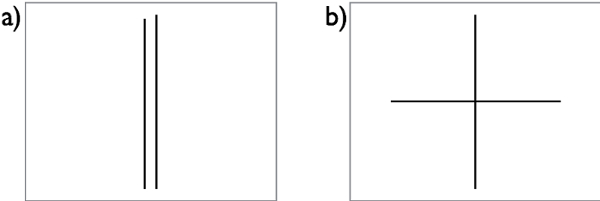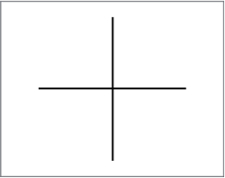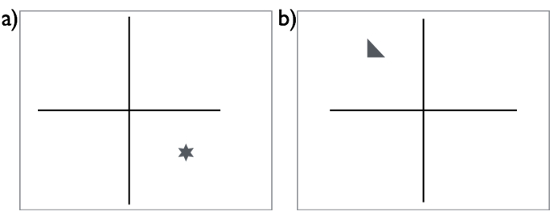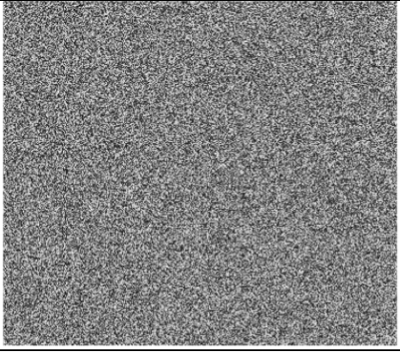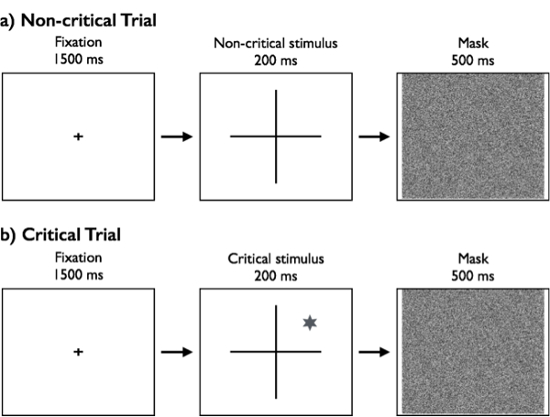We don’t always process the entirety of our physical surroundings—especially when our attention is too focused—which can affect what we perceive and ultimately see.
In a given environment, a person can be simultaneously exposed to different visual stimuli—including posters on a wall, components of a gaming system, or virtual zombies on a TV screen.
If one of these items is related to a challenging perceptual task—such as targeting multiple, advancing undead to beat a high score—an individual will focus on it.
As a result, limited or no attention is paid to preexisting objects in the room, or any novel thing that enters it—like a significant other who walks in.
Such lack of attention means that the game player’s brain does not effectively process the visual stimulus of their partner, and thus they do not see them. This phenomenon of having a salient object in view, without attending to it and therefore not seeing it, is called inattentional blindness.
Using the techniques of Arien Mack and Irvin Rock, this video explains how to generate stimuli, collect and interpret data, and it notes how researchers are studying inattentional blindness today.
In this experiment, participants are exposed to three trial conditions of attentional engagement—inattention, divided, and complete—and, within each, asked to report what they see.
Independent of condition, a single trial consists of three sequential components: a fixation point, the stimulus, and a mask. The first element, the fixation symbol, consists of a small, centrally-positioned cross that serves as a focus point for participants’ eyes.
This is followed by the stimulus, which can be either non-critical or critical. Although both consist of a large, centered test cross—much bigger than that shown previously—the critical stimulus contains an additional gray shape in one of the quadrants.
The trick here is that the two perpendicular lines, regardless of the type of stimulus, are different sizes: one is slightly shorter than the other.
Importantly, the longer of these two marks must be identified—a difficult objective that requires visual attention.
Since the gray shapes will be onscreen during critical trials, these items are meant to assess inattentional blindness—whether a participant reports seeing them.
The final component of a trial, the mask, consists of a grid in which squares are randomly set to black or white. This mottled image serves to flush the previously shown stimulus from the visual system.
The first condition of the experimental task, inattention, involves participants being shown the three components of a non-critical trial on a computer monitor, after which they must state which of the two perpendicular lines in the test cross is longer.
Afterwards, a second non-critical trial followed by a critical one are presented. The idea is that, since the goal is to identify the longer lines in the stimuli, participants dedicate the majority of their attention to the test crosses onscreen. As a result, limited attention is paid to the gray shape shown in the third, critical trial—it is being inattended to.
When the three trials have been completed, participants are asked whether—in any of the test crosses shown—they saw an unexpected object.
Here, and in subsequent conditions, the dependent variable is the number of participants that accurately state either the type of shape shown during the third trial—in this instance, a star—or the quadrant it falls in.
Based on previous research, it is expected that the majority of participants will report that they did not see any objects—aside from the lines in the crosses—during the trials, providing evidence for inattentional blindness.
The next condition, divided attention, follows the same format: longer lines must again be identified in two non-critical and then a subsequent critical trial.
However, the trick is that, since participants were questioned about unusual objects at the end of the inattention condition, they’ll now be on alert for such out-of-place items. In other words, their attention will be divided between identifying larger lines in crosses, and looking for odd images.
It is anticipated that—after the three trials in this group are presented—more participants will indicate that they saw a new gray shape compared to the inattention condition, emphasizing the role that attention plays in visual perception.
The final condition is complete attention, and—in contrast to previous sets—it is stressed that the long lines do not need to be distinguished. Rather, the only goal is to name any objects that appear onscreen during the trials, along with their location amongst the quadrant.
Other than the directions presented at its start, the format of this group is the same, and again involves two non-critical trials followed by a critical one.
As they are told to only focus on items other than the perpendicular lines, it is expected that participants’ complete attention will be concentrated on the gray shape that appears in the critical stimulus, and—similar to the divided attention condition—the majority of them will indicate that they saw it.
To prepare the stimuli for the experiment, begin by opening basic slide software on a computer. On a white background, proceed to draw a single, vertical line that is approximately 80% of the height of the slide.
Then, on the same sheet, create a second vertical line that is slightly shorter than the first—here, the smaller bar is 630 px, and the larger one 645—and rotate it 90°. Afterwards, center the two marks so that they intersect and form a cross in the middle of the screen.
Proceed to generate a second slide in the same manner, but instead rotate the longer line so that it forms the horizontal axis of the test cross. Once completed, these two slides will compose the non-critical stimuli.
To make the critical images, duplicate the sheets, and in the one containing the short horizontal line, use the shape tool to include a gray star in a random quadrant of the cross. Repeat this process for the slide with the long horizontal mark, inserting a gray triangle and a square for the third condition.
Then, on a new blank slide draw two short lines, each approximately 20 px in size. Next, arrange the bars so that they form a small cross in the center. This image will function as the fixation point.
Finally, open an additional white sheet and create the mask screen. To do this, construct a grid of repeating squares and randomly fill in some of them with black to make a checkerboard.
With all of the types of stimuli generated, arrange the order such that the first two sets of three slides in each group of three are the non-critical trials consisting of the fixation symbol, the test cross only—make sure to note where the longer lines were placed—and the mask.
For the third set in each cluster, repeat the same order, with the only difference being the contents on the second slide in the series. This should now contain the critical stimuli—both the lines and one shape.
Prior to starting the task, welcome the recruited participant and verify that they would like to take part in a short experiment on visual perception. Then, proceed to direct them to a computer screen on which the small fixation cross is already displayed.
Continue by pointing to the symbol onscreen, and instruct the participant to look at it and not move their eyes. Stress that the next slide—also with a cross—will be shown only briefly, and should be carefully studied to identify which of the two lines displayed on it is longer.
Upon ensuring that all questions have been answered, press the spacebar to initiate three trials of the inattention condition. For each, show the fixation symbol for 1500 ms, the non-critical or critical stimulus for 200 ms, and the mask for 500 ms.
Afterwards, inquire whether the participant saw additional images in any of the test cross slides, and expect that—for this condition—they will answer "No."
Record this response, and then run the three trials of the divided attention condition. Once all slides have been shown, again inquire whether the participant observed any unusual items, and anticipate that they will reply "Yes."
If they do, have the participant elaborate on what shape they observed, in which trial it appeared, and in what quadrant of the screen it was located.
After recording the divided attention data, inform the participant that they will be shown a final set of stimuli. However, stress that in this last group, they only need to report whether they see shapes aside from the crosses—the lengths of lines are unimportant.
End the experiment by running the complete attention trials, and noting what gray shapes the participant saw.
To analyze the data, for each of the three conditions—inattention, divided attention, and complete attention—calculate the percentage of participants that reported observing a gray item in the critical trial.
Keep in mind that in order for this object to be counted as "seen," the participant must either have accurately reported the shape—either a star, triangle, or square—or the quadrant in which it occurred.
Notice that, for the inattention group, only 40% of individuals reported being aware of the extra item, while the remaining 60% did not, providing evidence for inattentional blindness. Importantly, these results suggest that an item must be attended to, in order to be seen.
In contrast, approximately 95% of individuals in the divided attention group and 100% in the complete attention set observed the shapes, likely due to the fact that some of the participants’ attention was allocated to finding these items, thus enabling their brains to effectively process them.
Now that you know how visual, line-based stimuli can be employed to study inattentional blindness and what a person sees, let’s take a look at how researchers are investigating this phenomenon in other ways.
Up until now, we’ve focused on how visual-based tasks—such as judging lengths, like for cracks in a sidewalk—affect a person’s awareness of their surroundings.
However, other researchers are looking at whether talking on a cell phone—an auditory task that requires a great deal of a person’s attention—can influence what they visually perceive.
Such work has shown that pedestrians on cell phones demonstrate riskier behavior—like narrowly bumping into someone—than their non-talking counterparts.
Furthermore, these individuals even report that they fail to see outlandish stimuli that a researcher introduces into their environment—such as a clown on a unicycle—providing evidence for inattentional blindness, possibly caused by the perceptual demands of their conversation.
Other researchers are partnering with magicians—who routinely manipulate their audience’s attention during an act—to better understand different aspects of inattentional blindness.
For example, some work has paired a "disappearing" trick—whereby a performer makes an object, like a lighter, vanish into thin air—with eye-tracking technology.
When the eye fixation points of participants who claimed to have seen the lighter fall were compared to those from subjects who did not detect this action, in both instances it was found that individuals tended to focus on the magician’s face or the hand supposedly holding the flame.
These results demonstrate that it is where attention is directed—not necessarily where the eyes are positioned—that influences what a person sees.
You’ve just watched JoVE’s video on inattentional blindness. By now, you should know how different-sized lines—with or without gray shapes—can be used to assess a person’s awareness of their visual world. You should also understand how to collect and interpret visual perception data, and realize how directed attention—rather than eye position—leads to inattentional blindness.
Thanks for watching!















